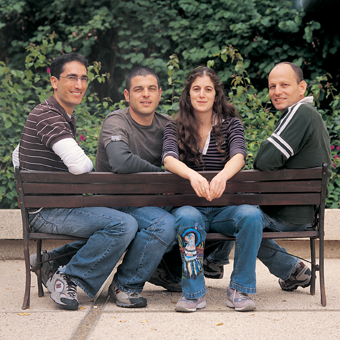Researchers from the Weizmann Institute examined the development processes of facial muscles in fetuses

In three articles recently published in the scientific journal DEVELOPMENT, the members of this research group published new and surprising findings, indicating a developmental closeness between some of the facial muscles and the development of the heart. Skeletal muscles and heart muscle develop from cells that originate in embryonic tissue called mesoderm. This is an early developmental stage, where the stem cells "make a decision" as to what type of cells they are going to differentiate into. The cells at this stage are called precursor cells. Thus, for example, there are kidney precursor cells, pancreatic precursor cells, muscle precursor cells, and among the muscle precursor cells it is possible to clearly distinguish cardiac muscle precursor cells (found in a certain mesoderm tissue in the fetus), and facial muscle precursor cells (found in another mesoderm tissue).
In the first study in the series, the scientists discovered that when facial muscle precursor cells are "removed from their natural context" in the embryo, and grown in cell culture, they become heart muscle and even begin to beat like it. This finding supports the idea that there is a developmental template - a sort of "default" - of cells in the mesoderm tissue in the fetus, according to which, in the absence of other instructions, the cells differentiate into heart muscle. Additional work carried out in Dr. Tzhor's laboratory showed that facial muscle progenitor cells from the embryonic mesoderm reach defined areas of the heart and integrate into them, near the exit of the large blood vessels (aorta and pulmonary artery). In this area, birth defects occur in a person with a relatively high frequency. The fact that in one out of a hundred births a certain defect in the heart is identified, gives this finding a special significance. In this work it was also found that a certain protein, BMP4, plays a crucial role in the differentiation of the muscle precursor cells in the head and heart. Addition of this protein in chicken embryos caused facial muscle progenitor cells to become cardiac muscle progenitor cells.
Surprising findings were also discovered in the opposite direction. Research on myocardial precursor cells has progressed in recent years as part of the development of regenerative medicine (tissue regeneration). The heart, like the brain, is traditionally considered an organ with no regeneration capacity, or with limited regeneration capacity. On the other hand, the skeletal muscles, including the facial muscles, have an efficient and proven ability to regenerate. Recently, cardiac muscle precursor cells were discovered in the mesoderm tissue in the embryo, which express (produce) a certain protein called Islet-1, which is related to the ability of cells to regenerate. These cells, which reach the heart, are considered a kind of "reserve soldiers" of the heart, and they settle and integrate in different areas of the heart. The fact that these cells produce Islet-1 and that they have the ability to regenerate, raises many medical hopes.
Dr. Tzhor and the members of the research group he heads marked cardiac muscle progenitor cells that produce Islet-1, in the mesoderm tissue of mouse and chicken embryos. Tracking these cells showed that some of them do reach the heart and integrate into it, and some - surprisingly - reach certain facial muscles, and especially the muscles responsible for opening the lower jaw, and contribute to them. This finding points to another developmental link between the muscles of the face and the heart. This phenomenon has ancient evolutionary roots. It turns out that in worms, which are heartless, the head muscles used for swallowing function like a dog. This fact suggests the possibility that the relationship between the development of the heart and the muscles of the head is an evolutionary remnant of an ancient developmental plan. Additional cells that play an important role in the development of the heart and the face are the cells of the neural crest. These cells, which originate from the outer tissue in the embryo (ectoderm), are capable of extensive differentiation. When they reach the face, these cells differentiate and form most of the bones, cartilage and connective tissues, while the mesoderm cells contribute to the formation of muscles.
Another study recently carried out in Dr. Tzhor's laboratory showed that the cells of the neural crest play a very important role in controlling the differentiation program and directing the mesoderm cells on their way to become muscle cells. In fact, it turns out that the cells of the neural crest "lead" the mesoderm cells to their appropriate place in the head, and there they instruct them to begin and differentiate into muscle cells. "They maintain complex, precise and timely interactions between them, which are essential for the proper conduct of both. Our ability to decipher the molecular component underlying these developmental programs is the key to understanding the genetic and cellular basis of many birth defects that affect the heart and the face at the same time." Such an understanding may contribute, in the future, among other things, to the development of ways to treat muscular dystrophy diseases that damage both the heart muscle and the skeletal muscles.
to a previous article on this topic

One response
It might be worth mentioning that in the embryo (the human at least) the cells from which the heart will develop are initially above the cells from which the head will develop. Only then is there a fold that brings them to their lower place